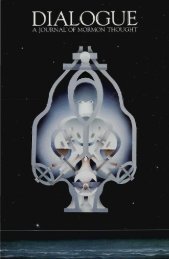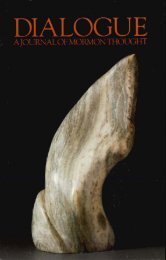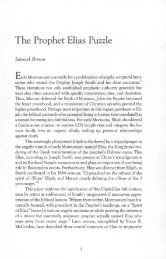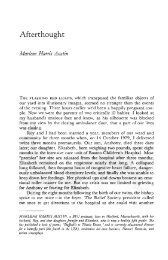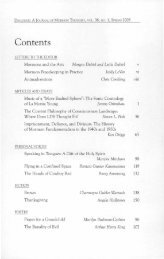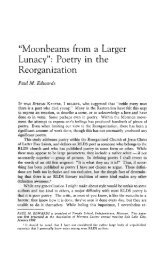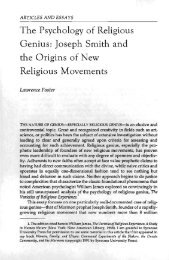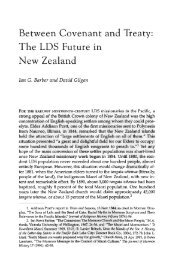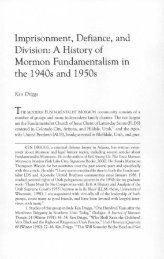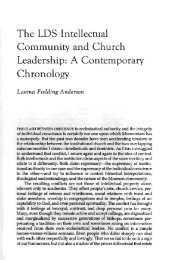Dialogue, Volume 25, Number 2 - Dialogue – A Journal of Mormon ...
Dialogue, Volume 25, Number 2 - Dialogue – A Journal of Mormon ...
Dialogue, Volume 25, Number 2 - Dialogue – A Journal of Mormon ...
Create successful ePaper yourself
Turn your PDF publications into a flip-book with our unique Google optimized e-Paper software.
Lindquist: The Bambara Mirror 55<br />
Any project in a developing country relies upon its primary laborers<br />
to initiate and effect change for the community. In Ouelessebougou<br />
that is the women. They maintain the family's private garden while<br />
assisting their husbands with the planting, weeding, and harvesting <strong>of</strong><br />
village or money crops; they are the water-carriers, the millet-grinders,<br />
and the fuel-gatherers; they tend the animals, cook the food, and care<br />
for the children. Women are not only central to health-care change<br />
but are also more likely than men to direct their educational and<br />
economic skills toward their family's welfare. However, second-class<br />
citizens in their own country, the women <strong>of</strong> Ouelessebougou have,<br />
until recently, been ignored by male-dominated development groups,<br />
who prefer to work with other men.<br />
The Ouelessebougou-Utah Alliance board, whose membership was<br />
90 percent male until 1989, has not been insensitive to Malian women's<br />
involvement in sustenance development. Male fact-finders traveled from<br />
Utah to visit with village leaders in 1985 and 1986, and they invited<br />
women as well as men to contribute to a needs assessment. In 1988 the<br />
board became convinced that, because <strong>of</strong> Bambara cultural prohibitions,<br />
Utah women would be needed to mediate with Mali women, so<br />
they established a separate women's board to advise them on related<br />
issues through the voice <strong>of</strong> its representative.<br />
It was the Ouelessebougou Women's Board that decided to sponsor<br />
the expedition <strong>of</strong> March 1989, in which I participated. Four board<br />
members and the female project director formed the nucleus; they<br />
were joined by the executive board chairman, his wife, and two other<br />
women —I was one — connected to the project only by interest. The<br />
expedition was designed to accomplish two main goals: (1) the women,<br />
all from <strong>Mormon</strong> backgrounds and seven <strong>of</strong> us unmarried and pr<strong>of</strong>essionally<br />
employed, would participate in medical or construction projects<br />
and hold discussions with Bambara women; and (2) the Alliance board<br />
chairman, a former LDS bishop, would introduce the expedition's<br />
female contingent to leaders <strong>of</strong> this patriarchal culture and evaluate<br />
the newly hired Malian director's management effectiveness.<br />
We eight women did not know each other well. A latecomer to the<br />
expedition arrangements, I assumed that the others clearly understood<br />
our goals. Only well into the trip did I realize that they were making<br />
the same assumptions. Still, I think it is fair to say that we were all<br />
anxious to involve the Malian women in the neglected but critical<br />
planning stage <strong>of</strong> production. We hoped to be able to live with them<br />
briefly to observe their routines, to gain their confidence in our commitment,<br />
and to ask them to prioritize their needs. Bambara and <strong>Mormon</strong><br />
together, we thought, could create substantive ways to address<br />
women's concerns. In actuality, the closest we came to staying with



